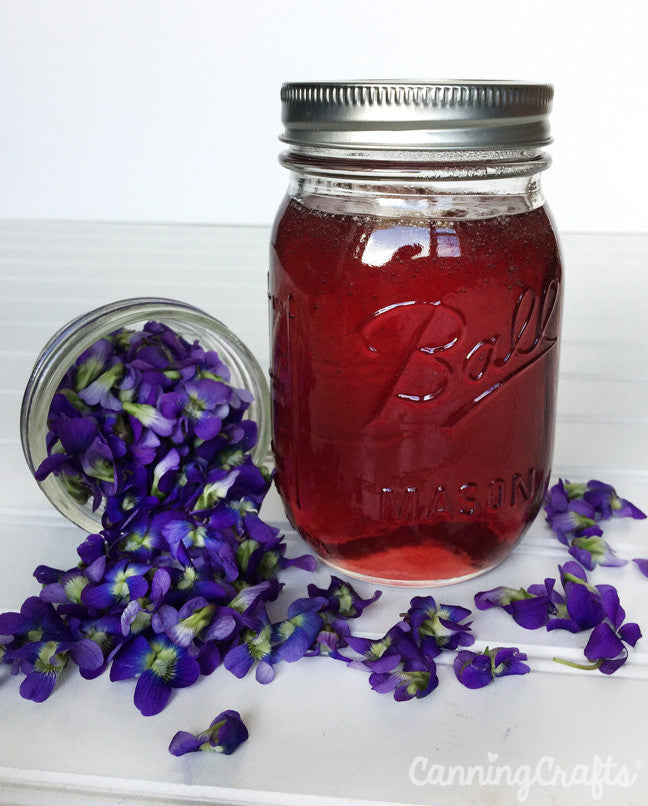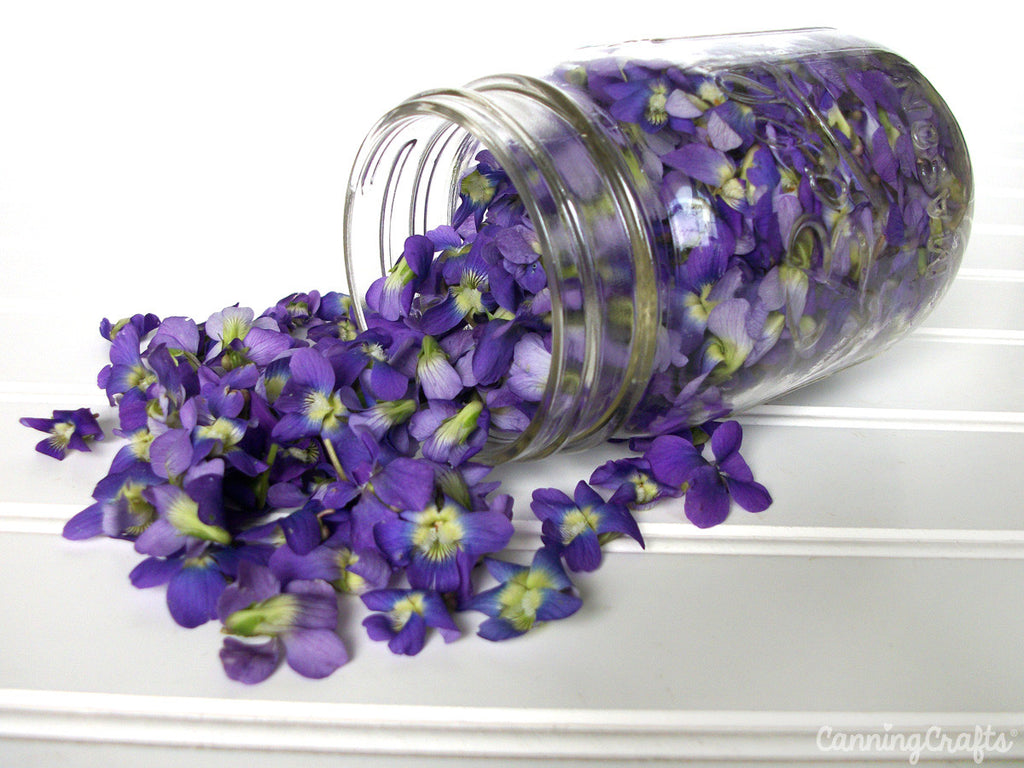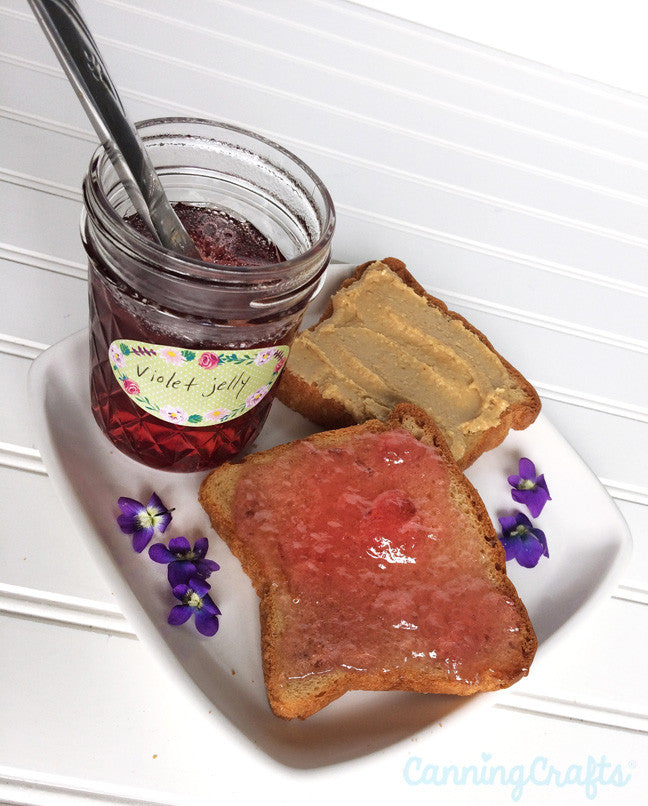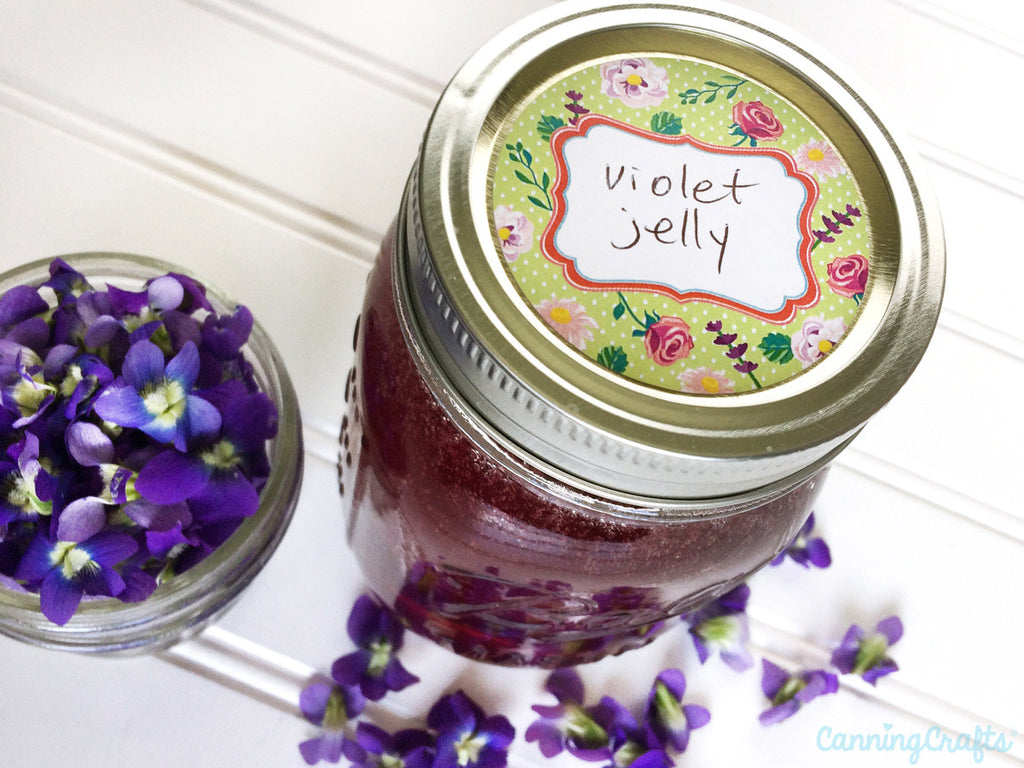Wild Violet Recipes: Foraged Edible Flowers Taste Great!
01. May 2017Our backyard was overflowing with violets, so I thought I would try this awesome Violet Jelly recipe from Bakers Brigade. Of course I'd heard of Dandelion Jelly, but I hadn't seen a recipe for Violet Jelly before.

I was really interested in the "magical color change" this food blogger spoke about. After collecting violets in a jar, you pour boiling water onto them. Then let the jar sit overnight to infuse and create a lovely sapphire blue "tea". When you strain out the flowers and add lemon juice, the dark blue tea turns purple. WOW! Just take a look at Bakers Brigade's cool color changing video or our time-lapse video.
Violet Jelly (makes approximately 4-half pint jars)
- 1 pint violet flowers (approx. 2 cups)
- 2 tablespoons lemon juice
- 4 cups sugar (*see low sugar recipe note below)
- 3 oz. liquid pectin
- Collect a mason jar pint full of violet flowers. Pour boiling water into the jar of flowers. Gently press the violets to release any air bubbles. Cover the jar and keep out of the sun for 24 hours. By the next day, the violet “tea” will be sapphire blue.
- The next day, strain your violets through a colander lined with a coffee filter or paper towel. I also squeeze the flowers to release all the juices. You will need 2 cups of liquid, so you may need to add a little more water to the violet tea.
- Mix the tea and lemon juice in a large pot. At this point, you will see the dark blue tea turn purple. Oooooh aaahhhh. Magic! Bring the liquid to a boil and continue to boil for one minute. Add sugar and pectin, then bring to a hard boil one more minute. Turn the heat off and skim the top of the jelly if needed.
- Pour into sterilized mason jars. Makes approximately 4 half pints of jelly. Let cool and store in the fridge.
Note: You could process the jars in a water bath to make them shelf stable, however, you would need to collect an awful lot of violets to make processing them worth it in my opinion. I’ve always just gotten enough violets for a few half pint jars at a time.
Low-Sugar Recipe: Pomona's Pectin has a low-sugar Violet Jelly recipe. I recently tried this recipe and it tastes great! Pomona's pectin is a 2-part pectin that uses calcium water that allows you to drastically reduce the amount of sugar in jam and jelly recipes. Some Pomona's Pectin recipes reduce the sugar by 50% over a traditional recipe. So if you want to reduce sugar in pectin recipes, this is a good option.

Our Cottage Chic Flower oval jar labels fit quilted canning jars, perfect for flower jelly!
The resulting jelly is very sweet with a subtle floral taste. And the color is simply amazing! Who knew flowers could taste so good? If you have an abundance of these beautiful purple flowers in your yard, go pick them now! Violets are unlike dandelions, they won't last all season in your yard. Wild violets are typically found May through June in most areas (zones 3 through 9).
Shop for Floral Canning Labels to decorate your jam & jelly jars.
If you don't want to make jelly, you'll be happy to know there are plenty of other violet recipes to try.
Violet Recipes:
- Sweet Violet Syrup
- Candied Violets
- Violet Sugar
- Violet Jam
- Violet Jelly
- Violet Muffins with Violet Sugar
- Violet Vinegar
- Violet Salad
- Violet Leaf Tea
Violet Lemonade Recipe
The process is pretty simple for violet lemonade. Spend hours collecting tiny violets in a mason jar, steep with hot water, strain out flowers, then add lemon juice. While it's back breaking collecting so many teeny-weeny flowers, it's worth it to witness the "magical" color change. After soaking the flowers overnight, the resulting liquid is a lovely sapphire blue. But once you add lemon juice to the strained solution, it turns purple. Ooooo aaaahhhh. Magic.
I tested two batches of violet lemonade. For the first batch, I filled a pint mason jar HALF full of flowers. The second batch had a mason jar packed FULL of violets which resulted in a much darker navy blue color. I used one large fresh squeezed lemon and added several tablespoons of raw sugar.
But wait, the color change is NOT magic. It's SCIENCE! You all know I like science. So WHY does the liquid change from blue to purple? It’s a basic acid/base chemical reaction. The anthocyanins (color pigments) in the violets (the base) are reacting to the lower pH from the lemon juice (the acid). oooooo SCIENCE!
Violets have always been seen to have medicinal and even mystical properties. In the 10th century tome “Macer’s Herbal”, violets are noted to be powerful to combat “wykked sperytis”. 👻 Part of the mysticism surrounding them comes from their extract turning from dark purple to magenta when combined with lemon juice. Witness the magical & scientific color changing video below. Mwahahaha.
Violet Lemonade Ice Cubes Recipe:
When life gives you violet lemonade, you should make violet lemonade ice cubes! These tri-colored ice cubes are like a beautiful watercolor painting. It just takes a little patience to make the cubes because you have to freeze them in steps. You’ll need equal parts of blue violet water tincture and violet lemonade.

To Make the Violet Lemonade:
- Add boiling water to a mason jar full of violet flowers. For the darkest blue water, steep overnight in refrigerator.
- Strain flowers from the blue violet water.
- Divide the blue violet water into two separate mason jars.
- Add lemon juice to ONE of the blue mason jars. The blue water will magically turn purple. Watch our color changing video. Oooooh Ahhhhh.
- Optional: Add a little sugar to the lemonade mix.
To Make the Violet Lemonade Ice Cubes:
- Freeze violet flowers in ice cube trays with a small amount of water, about 1/4 inch. Make sure they are completely frozen before moving on to step 2.
- Remove ice cube tray from freezer and add about 1/4 inch of violet lemonade. Put in freezer until completely frozen again.
- Remove tray from freezer and add about 1/4 inch of blue violet water. Put in freezer until completely frozen again.
- Once the cubes are fully frozen, add them to violet lemonade, water, or other beverages.

Violet Infused Vinegar Recipes
I tested three different violet infused vinegars. For each, I filled a mason jar half full of violets. Then I filled each jar with a different vinegar. I used plain white vinegar, white rice vinegar, and a white wine vinegar. I added a piece of parchment paper under my metal rings so the vinegar didn't react with the metal. I then stored the jars in a cool dark place for a week. After a week or two, strain the violets from the vinegar. Each vinegar turned a lovely pinkish color from the violets. I'll make salad dressings with these colorful vinegars later this spring.

Wild Violet Lemon Cookie Recipe
Our Wild Violet Flower Lemon cookies are a real head turner! They are also a fun project for kids to help make. If you have an abundance of wild violet flowers in your yard, give this fun and healthy recipe a try. It will wow your friends and keep your kids busy in the yard. Read our blog post to get the Wild Violet Lemon Cookie recipe.
Violet Salad
You don't need a "fancy" recipe to eat violets. Besides eating them in jelly, cookies, or vinegar, you can eat the fresh in salads. Fix up any basic salad by topping it off with a sprinkle of fresh violets and a sweet vinaigrette.

Nutritional Benefits of Wild Violets:
So why eat violets? Well, they have fantastic health benefits much like dandelions. According to The Herbal Academy, violets have been used to treat:
- coughing and bronchitis
- colds and sore throats
- cystitis
- rheumatic complaints, reduce inflammation
- eczema
- psoriasis
- acne
- cradle cap for babies
- and even cancer!
Violets have ample Vitamin C and A as well as other vitamins and minerals. Violet leaves are also sold as a supplement.

Harvesting Wild Violets:
There are 40-50 violet species in the US according to The Herbal Academy. Here's another handy website to help identify violet species. The medicinal properties of most wild violet species are interchangeable. They are NOT to be confused with the African Violet houseplant which will make you sick if eaten. Wild violets are typically found May through June in most areas (zones 3 through 9). Much like foraging for other edibles, be sure to harvest in areas free of pesticides. Avoid flowers in yards where pets may go to the bathroom as well. Harvest flowers and use fresh soon after picking or dry for later use.

Our Cottage Chic Flower canning labels look great on any flower jam or jelly jars!
Want to know more about eating flowers! Read our blog post on Using Dandelions as Food & Medicine.

Sign up for our newsletter to get more gardening tips, product updates, & a 10% off coupon on your first order of canning labels in our shop.


















Comments (15)
Do you know if you can use the white violets? I have tons of them all over my lawn. I would also imagine you could use the juice as a dye.
Patricia, lighter colored violets would probably work, but I’m not sure what the jelly would look or taste like.
I made this 2 days ago and love the flavor. The color is beautiful. I’ve seen this post before and thought that I need to give it a go and was thrilled with the results.
I’m so glad you liked the violet recipe Robin! The jelly has the prettiest color I’ve ever seen.
On the jelly recipe, how is it that you start with 2 cups of tea, add 4 cups of sugar and end up with only enough jelly for one jar? Just trying to clarify before I get started!! Thx!
Shirley,
I clarified our recipe. You collect and steep violets in a pint mason jar. But the final recipe should make around 4 half pint jars.
Thanks!
Alison
CanningCrafts
Thank you Lexie , this looks wonderful I’m going to try this
How long does the violet tea keep in the refrigerator? I steeped the violets for 24 hours, strained it and put it in the fridge 4 days ago. Is it still good?
I planned on making jelly right after making the tea but that didn’t happen.
Janet,
The tea you made should still be good to use even after 4 days.
Alison
CanningCrafts
Where does one find calcium water?
Marian,
Pomona’s Pectin is a special pectin that COMES with calcium water. It is available at many grocery stores or can be purchased online. This special pectin is unsweetened, preservative-free, and jells reliably with very low amounts of any sweetener.
When using Pomona’s, you will find two small packets of powders in the box: a pouch of pectin and a separate pouch of calcium to make the required calcium water. So if you want to try making a low sugar jam or jelly, look into this special pectin.
https://pomonapectin.com/
Alison
CanningCrafts
24 hours ago I started infusing white wine vinegar. In a week or so I will add olive oil, salt, pepper and a bit of sugar to make a vinaigrette.
Also started brewing a violet hibiscus wine. Using a mesh bag, add 2-3 cups of violet petals, 4 ounces of dried hibiscus, 1 orange sliced and muddled, 1 lemon sliced and muddled, 2 ounces of golden raisins chopped, 5 cups of sugar and 1 gallon of hot water. Let that sit for 24 hours. Then add yeast, yeast nutrient. Put the lid on the brewing bucket with a water lock for 1 week. After 1 week, remove the mesh bag and transfer the wine must to a sanitized carboy with a water lock. Rack and re-rack as needed. When the fermentation stops and there are no more bubbles in the water lock, bottle the wine.
Currently, I’m at the step of adding yeast. The wine must smells amazing already and so is the color, kinda deep purple.
Can I use powdered pectin?
Why does my tea not taste anything like berries? I’m steeping them now. I had 4 cups violets to 8 c water. Did I use too much water? Tastes more like a lettuce
Judy,
Violet tea will have a subtle floral taste. I don’t think it will taste like berries, but perhaps it does to some people! Tastes do vary :)
I would suggest a 1 to 1 ratio of water to violets. Or even more violets than water if you want a more intense tea. It sounds like your batch would’ve been more diluted if you used twice as much water.
Alison
CanningCrafts